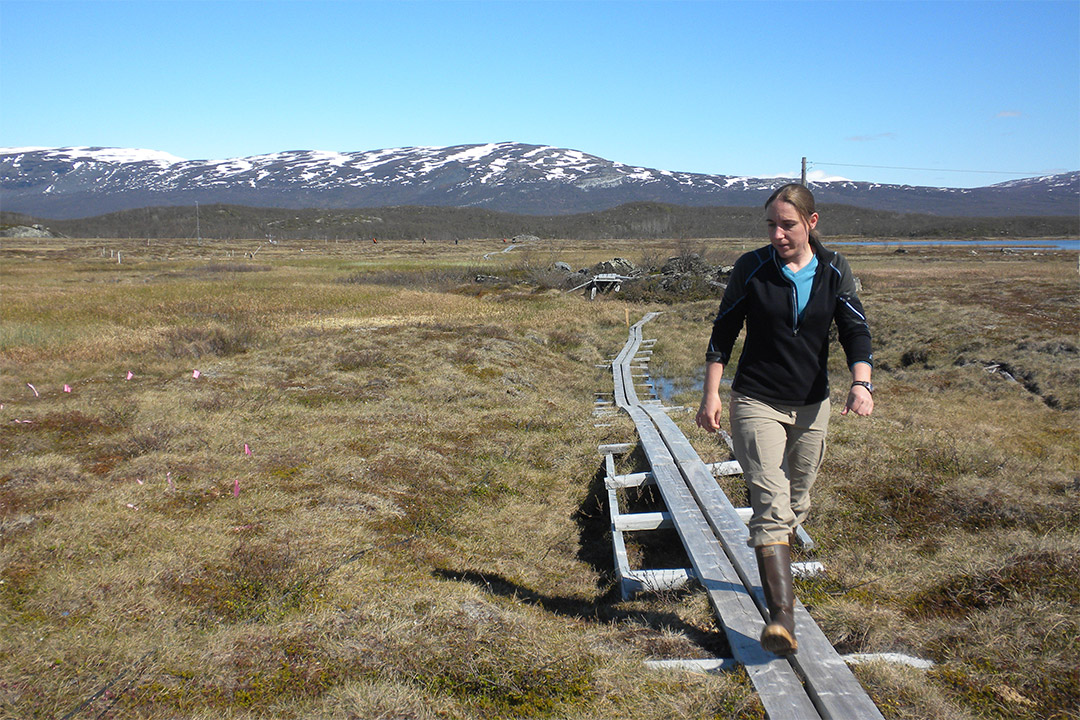RIT collaborates with 13 other universities to understand climate change and ecosystems
Assistant Professor Carmody McCalley leads RIT’s contributions to NSF-funded institute
RIT Assistant Professor Carmody McCalley at the research site Stordalen Mire in Abisko, Sweden. She will lead RIT’s contributions to EMERGE, a new NSF-funded Biology Integration Institute that will focus on better understanding ecosystem and climate interactions like the thawing of the Arctic permafrost.
Rochester Institute of Technology is one of 14 universities from around the globe that have collectively been awarded $12.5 million from the National Science Foundation (NSF) to launch a new Biology Integration Institute (BII). It will focus on better understanding ecosystem and climate interactions—like the thawing of the Arctic permafrost—and how they can alter everything from the landscape to greenhouse gases.
EMERGE, which stands for “EMergent Ecosystem Response to ChanGE,” is an ambitious five-year project that will concentrate on discovering how the processes that sustain life and enable biological innovation operate and interact within and between each other—from molecules to cells, species, and ecosystems—under dynamically changing conditions. The end result will be a new “genes-to-ecosystems-to-genes” framework to create models that could help predict ecosystem response to change.
“The big goal is to see if we can do a better job at predicting how ecosystems respond to climate change and develop a better understanding of how molecular-scale and large-scale processes interact,” said Carmody McCalley, an assistant professor in the Thomas H. Gosnell School of Life Sciences and the principal investigator for RIT’s contributions to the project. “We’re attempting to achieve that by bringing together a large, interdisciplinary group. The key is collaborating across disciplines—everything from high-end molecular genomics to ecosystem modeling to isotope geochemistry.”
McCalley is an expert in isotope geochemistry and looks at the isotopic composition of methane to determine where methane molecules came from. Changes in the isotopic signature of methane coming from a thawing permafrost system can indicate there has been a change in the biology and physics of how methane moves through the environment. The College of Science faculty member will work with her collaborators in fields such as microbial genomics and biogeochemistry to link those changes to causes and effects.
The project will be led by The Ohio State University and will consist of a team of 33 scientists representing 15 specialties. The partnership brings together expertise inside and outside of biology, such as ecology and evolution, organismal biology, team science, and modeling and computational science.
“Ecosystems respond to changing conditions, like a new agricultural practice or changing rainfall patterns, in a way that is greater than the sum of the responses of individual parts,” said Virginia Rich, associate professor of microbiology at Ohio State and co-director for EMERGE. “To address this challenge head-on, our team will pull cutting-edge ideas and methods from across biology and beyond into a unified vision for seeing what each discipline, alone, cannot—piecing back together the forest from the trees, if you will. It is incredibly exciting.”
The research will be done in Stordalen Mire, a long-studied peatland in northern Sweden where permafrost thaw drives changes in the landscape, plants, and microbes. The institute, which will launch in September, will also have a strong training, education, and outreach component and will involve biologists at the postdoctoral, graduate, and undergraduate levels.
Participating universities include University of Arizona, Florida State University, Colorado State University at Fort Collins, Case Western Reserve University, University of California at Berkeley, Rochester Institute of Technology, Berkeley Labs, Joint Genome Institute, all in the United States; Lund University, Umeå University and Stockholm University, all in Sweden; and Queensland University of Technology in Australia.
